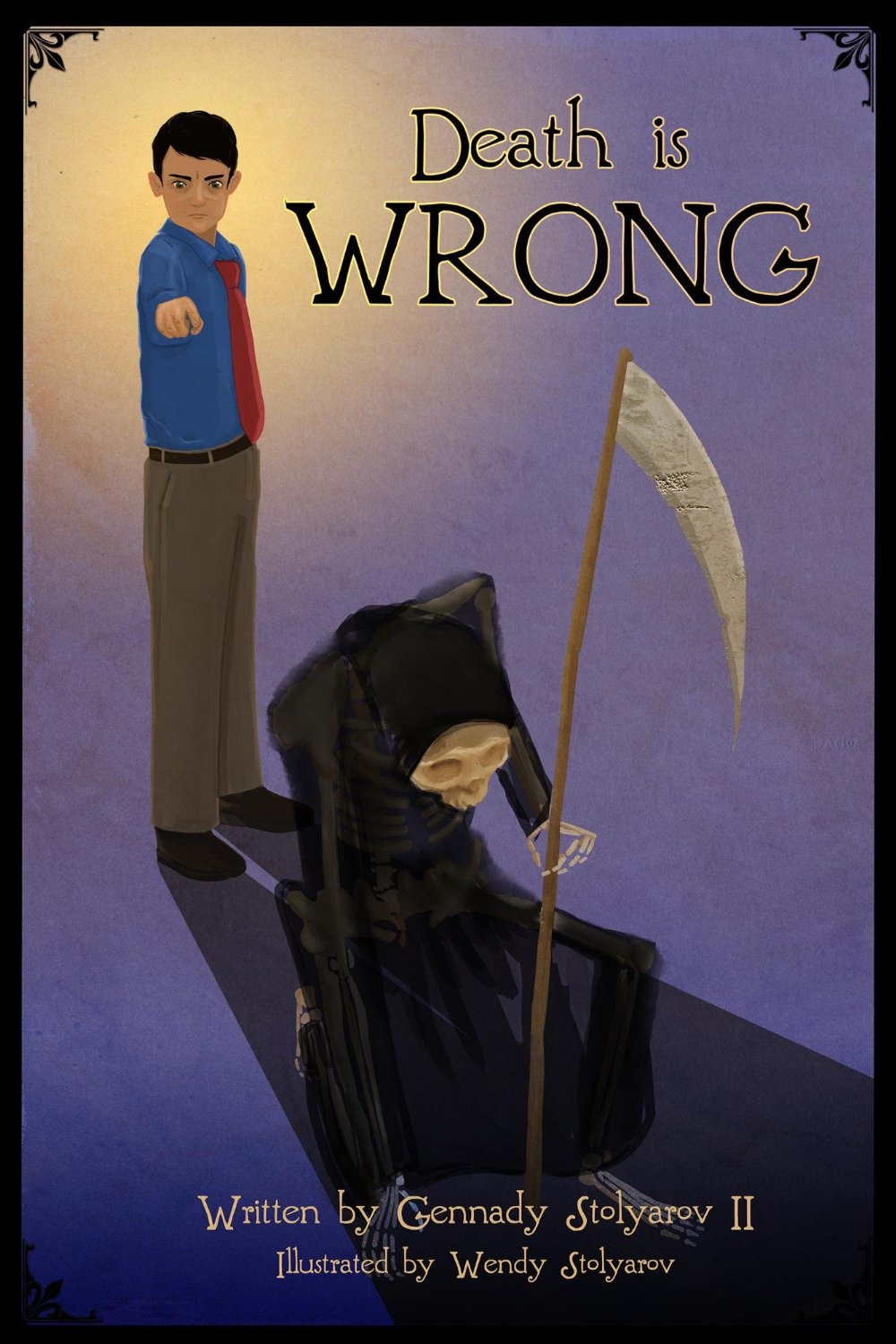There is an article at Slate that talks about the children’s book Death is Wrong and the fundraiser to distribute 1,000 copies of it to children.
The article’s author, Joelle Renstrom, writes,
“In late February, Stolyarov and the Movement for Indefinite Life Extension started an Indiegogo campaign to raise $5,000 to distribute 1,000 free copies to kids. The campaign ends on April 23, and so far the funds fall well short of the goal.”
The goal is 33% funded after 33% of the days. That seems right on track to me. I don’t know why Slate would feel the need to exaggerate that point to make it seem like our funding progress was not favorable to us.
“But there’s a difference between curing grave diseases, which would increase our lifespans, and ‘solving’ death. Stolyarov sells kids an updated myth of pharaohs, the fountain of youth, and Gilgamesh cloaked in the singularity, the theorized point at which technology and superior artificial intelligence fundamentally alter life. He implies that death is the Problem and that solving it will ensure smooth sailing, which is irresponsible at best and disastrous at worst.”
To imply that death isn’t the problem, that you can go through deaths of people you know and then yourself, and that it is not worth smoothing out those parts of the seas of life, and to call it irresponsible and possibly disastrous to do so, is unfounded, self-back-patting – assertive flippancy at its finest. No offense. I’m sure Ms. Renstrom has plenty of redeeming qualities, but that statement is not one of them.
Sure, we fight to keep death at bay indefinitely, but we will be happy if the world’s collective efforts help lead to 500-year lifespans, or 200-year lifespans, or indefinite life spans with 77% of people dying by accident within the first 800 years anyways, etc. We support a variety of potential pathways that could bring about more good futures for more people. We support anti-aging research initiatives like SENS and many others. The critics at Slate think they’re clever for associating what we aim for with the negative image of immortality as portrayed by book and film sensationalists that make up immorality-themed stories. In the movies, it is the unspoken word that Zombies are only supposed to move slowly, but that is irrelevant to life and death causes, too.
Having a trendy, knee-jerk, cynical, superficial response to this life-and-death topic is not acceptable. Think this through more. It is, “life is good; make it work”, not, “life could be bad; justify why it’s good before making it work”.
“Stolyarov rails against acceptance, even when unaccompanied by belief in the afterlife; he rejects the Buddhist position of experiencing pain caused by death while knowing death has released a loved one from suffering. Instead, he targets an audience that could conceivably solve death before he has to stare it down, which is neither braver nor better.”
He is working on one of the most intellectually forward moving projects of our times, and he does it in a world where primary and secondary schools don’t put a lot of critical-thinking coursework into their curricula, and where it shows. It’s a world where 85% of the people claim that they know an invisible pal in the clouds can be telepathically begged to bend the laws of physics for them. Of course what he is doing is great and brave; he stands up in the face of and helps the as-of-yet ungrateful, often antagonistic masses.
“Death Is Wrong makes immortality seem within reach, describing doubling a roundworm’s life via genetic mutation and the cell-rejuvenating Strategies for Engineered Negligible Senescence proposed by bio-gerontologist and anti-aging crusader Aubrey de Grey.”
The tools to do it are here now. It is within reach. For example, diseases that are like the forms of damage that accumulate in and around the cells of our bodies and that cause us to age to death, have already been worked on with success in laboratories around the world. Also, some gene recombination has already stopped some diseases. We know how to work on this kind of stuff. We just have to determine to get it done now. So let’s rally people to this cause rather than directing them away from it.
“Representing a legitimate problem as a solution invites disaster, especially if it means ignoring issues such as overpopulation.”
Population is on a decline in many industrialized countries when you subtract immigration. So there is one of many solutions to a potential overpopulation crisis.
I often have to wonder why life-extensionists have to be the bearers of facts like these to people who use these concepts to try to discredit projects and organizations of life-and-death significance. It’s one thing to work to discredit people; it’s another thing to do it without having your facts straight, and it’s yet another messed-up thing altogether to do all that, but not even inquiringly or half-jestingly, but assertively.
What about the potential underpopulation crisis?
But it doesn’t even matter in this context; death comes first. If you’ve got two problems, and impending death of you and people you know is one of them, then you work on the death as the top priority. Death is definitely not the hands-down, go-to solution when you think about a may-be/could-be population challenge of an unknown form. It’s way down at the bottom of that list, if it’s even on there at all. In the meantime, many groups and organizations continue to work on forecasting for and planning for scenarios like those. It’s a nearly moot alarmist point to say that transhumanists and supporters of indefinite life extension can’t and don’t think of the big picture of things. I like Joelle Renstrom’s concern for it, though, and I encourage her to get involved with one of those organizations, too, and help plan ahead.
“The transhumanist declaration acknowledges technology’s double-edges: “humanity faces serious risks, especially from the misuse of new technologies. … Although all progress is change, not all change is progress.” This consideration is missing from the book. Part of preparing kids for a technological future is teaching them that not all technology is necessary or beneficial, and that we can make technological mistakes. Putting all our eggs in the “technology will fix everything” basket is even more dangerous than putting them all in the “death is wrong” basket. What if technology doesn’t cure death? What if it, or the rush to develop it, actually causes death?”
What if, in our rush to quadruple-check every “what if”, we forgot to move forward toward the cures, and we all died needlessly? People like me, Gennady Stolyarov, and many others work with projects that help advance our understanding in those regards, too. Why would we even be accused of neglecting those considerations? We don’t support pioneering of new ground by putting on blindfolds and running at full speed through the jungle swinging a machete. Hey wait, I think I just described a straw-man that the author of this article created. I’m calling “straw man” on that point.
The presentations at the conferences we support, the authors of the books we help promote, the organizations we choose to associate with — they talk about, monitor, work with, and report on risks, ethics, sustainability, and related matters all of the time. We or people that we know, work with places like Longecity, SENS Foundation, Methuselah Foundation, Fight Aging, Campaign Against Aging, Coalition to Extend Life, Longevity Alliance, Maximum Life Foundation, Humanity+, Lifeboat Foundation, IEET, Singularity Network, Foresight Institute, Cryonics Network, and many others.
“Stolyarov might argue he’s advocating adaptation, and thus survival, but curing death would constitute artificial selection—a drastic and deliberate change in our own evolution. Inherent in that argument is a troubling notion of human exceptionalism—that we shouldn’t have to play by evolution’s rules. Stolyarov suggests we select ourselves (those who can afford it, anyway), rather than leave it to nature.”
Artificial is a kind of natural. It is natural for humans to use their tools and abilities to do what they can do with them. Human beings are exceptional. The universe didn’t (seemingly) sit empty for millions of years, with dust balls whistling in the wind, comets and cosmic gas flying by, no sentience or record of such, and then have the miraculous occurrence of sentience through human form spring up from that dust—just so that this intellectual power-tool in a land of endless wonder, potential, and mystery, could decide itself to be less significant than the ducks and the trees and allow itself to disassemble from its miraculous, universe-control-potential form, back into inanimate dust and vapor trails. It is important to use our human opportunity to leverage resources to uncover as many of the mysteries of the big picture of existence as possible.
“Kids could grow up not just afraid of death, but also afraid of failing to fix it. Stolyarov makes death a powerful nemesis that could rule their lives—just as it’s ruled his.”
What an insulting and baseless speculation to assert. If you’re going to insult somebody, at least add enough fallacy-free substance to it to hold it up.
People like the author of the Slate article want children to continue growing up afraid of life. They want death to continue to drag down their spirits and traumatize them. They want children to think that wars and the greedy people make death an appealing and noble exit. They tell people that it’s better to be intellectually lazy and forget about working on their challenges, that it’s better to lay down and die, that life is too hard and dreary. They don’t want children to think about fixing death, because they can’t conceive of having a spine when it comes to standing up to tough danger. They want indifference to remain a powerful nemesis that rules children’s minds, so they can’t see the true dangers in death and respond appropriately.
Eric Schulke was a director at LongeCity during 2009-2013. He has also been an activist with the Movement for Indefinite Life Extension and other causes for over 13 years.

















